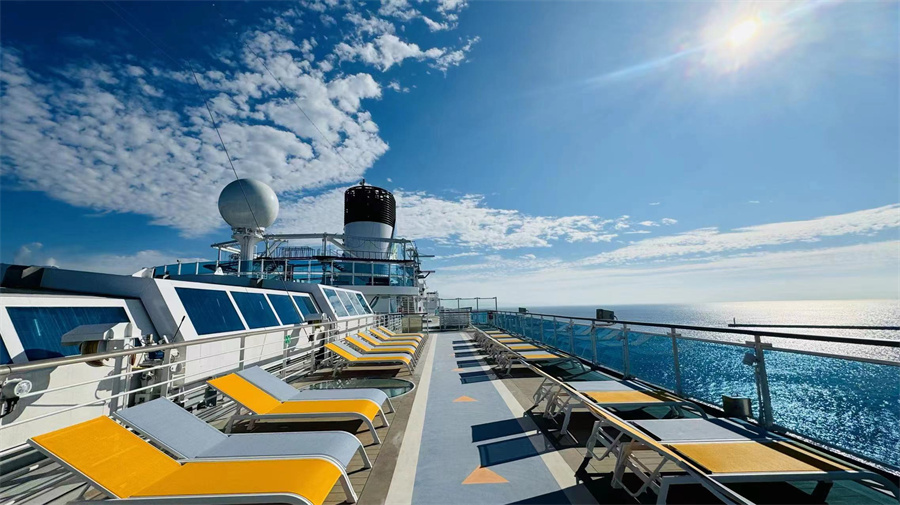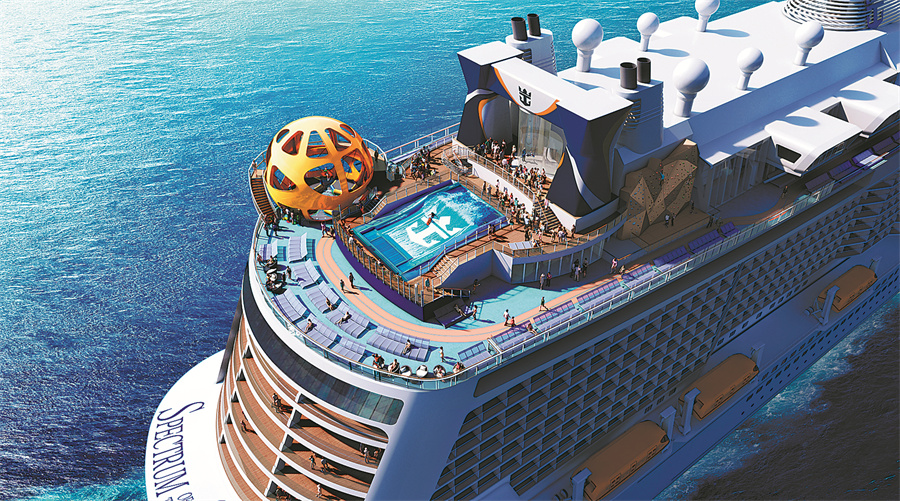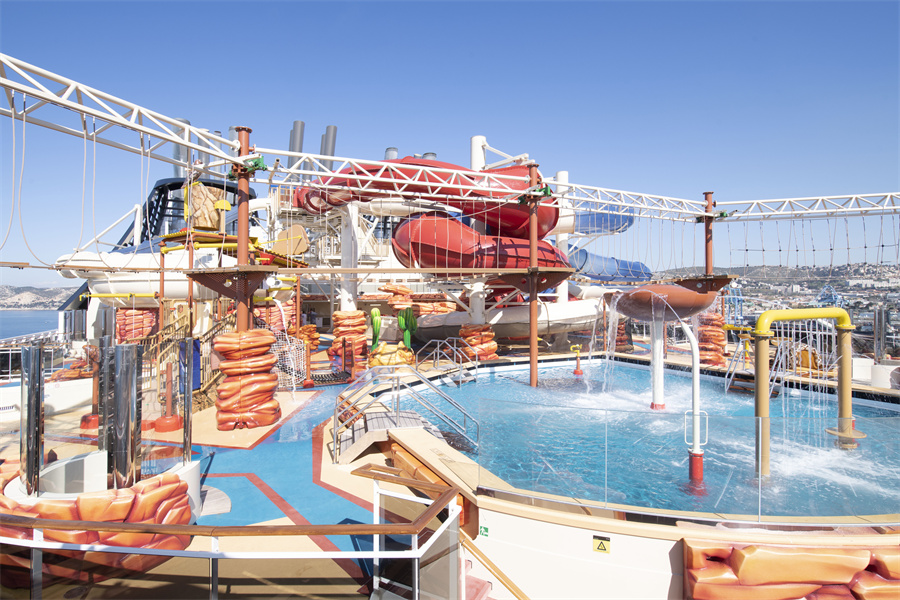Cruise ship industry poised for new golden era

The deck and the Cafe 1508 onboard Adora Magic City. [Photo/China Daily]
Amid the global recovery in cruise ship travel, the revived Chinese market is eyeing unprecedented opportunities that are expected to usher in a new golden era for the industry, experts said.
At the end of 2019, before the COVID-19 pandemic, China was the world's second-largest cruise ship travel market after the United States, said Zheng Weihang, executive vice-president and secretary-general of the China Cruise and Yacht Industry Association.
With Chinese and multinational cruise companies recently resuming operations, China is confident it can return to the 2019 level within two years, and kick-start a new lucrative period for the industry starting in 2026, Zheng said.
A joint guideline issued by ten government agencies, including the Ministry of Transport, aims to grow the Chinese cruise market into one of the most dynamic ones in the world, with annual passenger trips expected to reach 14 million by 2035.
Compared with the last cruise ship travel boom from 2008 to 2017, the new "golden decade" is expected to have different characteristics, including more tailor-made cruise products and joint development of the sector's industrial chain, Zheng said.
"We are going to see more diversified cruise trip options, a rising number of people devoted to the cruise industry, and a wider array of guest services on cruise ships supplied from China," he said.

The deck and the Cafe 1508 onboard Adora Magic City. [Photo/China Daily]
Global players
On Saturday, Switzerland-headquartered MSC Cruises resumed its Chinese port operations in Shanghai. Its flagship vessel, the MSC Bellissima, became the first international cruise liner to sail from the Chinese mainland since the pandemic.
"This marks an important milestone in the global cruise industry's recovery," said Gianni Onorato, CEO of MSC Cruises, at a ceremony on Friday to celebrate the event.
"The restart of international cruise operations from China sends a strong signal to the world, and we are glad to experience the incredible speed of recovery here in the Chinese cruise market."
Onorato said the resumption of operations reaffirms his company's commitment to China, which remains as strong as ever.
"China continues to play an important strategic role for MSC Cruises," he said.
The 172,000-gross-tonnage MSC Bellissima is the largest cruise ship operating in Asia. The liner can accommodate up to 5,686 guests in 2,217 cabins. MSC Cruises is the world's third-largest cruise operator by passenger capacity.
"We are fulfilling our commitment to bringing to the region a modern Asian flagship and we are dedicated to further investing in China and benefiting the local economy," Onorato said.
On Friday, MSC Cruises also announced its 2024-25 winter schedule for China, with two ships to operate from four Chinese ports in the first year of the company's return to the region.
"This is the right time for growth. That's why we are very confident that China's market was waiting to see more ships," Onorato said.

Spectrum of the Seas is due to sail from Shanghai in April. [Photo/China Daily]
MSC Cruises is not alone. On April 27, the world's largest global cruise line operator, Royal Caribbean International, will sail Spectrum of the Seas from Shanghai.
Up until May 2026, Royal Caribbean will offer more than 120 cruises, with itineraries ranging from four to seven nights, and destinations in Japan including Tokyo, Osaka, Kobe, Fukuoka, Kumamoto, Nagasaki, Kagoshima and Okinawa.
"Since we opened sales on June 29, 2023, bookings for cruise ship travel have been surging, and family suite options are already sold out," said Liu Zinan, senior vice-president of the Royal Caribbean Group.
Liu anticipates that "booking volume in the second quarter of this year will be four times that of the pre-pandemic period, with a potential nine-fold increase compared to historical levels in the third and fourth quarters."
Royal Caribbean was one of the first international cruise companies to enter the Chinese market and has cultivated it for 15 years, said Liu, who is also chairman of the Royal Caribbean Cruises in Asia.
"Royal Caribbean has played a catalyst role in fostering a golden decade of cruise development over the past decade, witnessing the remarkable growth of the Chinese cruise industry during its golden age, with annual growth rates exceeding 50 percent," Liu said.
In recent years, the development direction of China's cruise industry has become more diversified, he said.
"After three years of reflection, consumers' demand for cruise products is changing, which also brings us new market opportunities. For instance, there is an emerging trend toward younger demographics and an increasing desire for diverse onboard entertainment experiences, which require guest services to become more diversified for different age groups," Liu said.
Huang Ruiling, president of MSC Cruises China, said: "We have upgraded many dining options and added some Chinese cultural elements to suit Chinese tastes."
Huang described MSC Bellissima as a vessel with Chinese imprints. "From the ship's repairs and maintenance, procurement of raw materials and supplies, to staff recruitment and operations, this is a cruise ship that has been upgraded specially for the Chinese market and the preferences of Chinese consumers," Huang said.
After home port operations resume in China, all the produce for Chinese cuisine served onboard will be procured locally, she said.
In order to better serve its Chinese guests, up to 25 percent, or 400 of MSC Bellissima's crew members, are fluent in Chinese.

Adora Magic City undergoes a trial voyage before its launch in 2024. [Photo/China Daily]
Chinese factor
In the past, the rapid development of China's cruise industry relied heavily on international operators driving growth in the sector, but domestic companies are now major players.
"In the past few years, the participation of Chinese cruise companies including Adora Cruises and China Merchants Viking Cruises has not only brought more capacity to the Chinese cruise market, but also prompted the overall cruise industry chain to improve and develop," said Qiu Ling, chairman and deputy director of the Shanghai International Cruise Business Institute.
The launch of Adora Magic City, the first domestically built cruise ship, was a milestone for China's cruise industry.
"Since its maiden commercial voyage on the first day of 2024, Adora Magic City successfully completed 16 trips as of March 9, and its guests cover people born in the 1940s to Generation Z," said Chen Ranfeng, CEO of Adora Cruises Ltd.
Adora Magic City has already announced its itinerary for the year and will sail from Shanghai to destinations in Northeast Asia. The entire Adora fleet will be deployed to multiple ports in East China, South China and North China year-round, with mid- and long-haul journeys to countries including Japan and South Korea as well as ports in Southeast Asia.
"We have already received an abundance of inquiries and bookings for the summer season," Chen said.
Qiu said although Adora Cruises is in the very early days of serving the Chinese market, operations have so far gone smoothly.
"Taking the Adora Magic City for instance, we have constantly seen the vessel improve its efficiency and procedures, optimize service quality and enhance passengers' experiences. Such development also indicates the vessel's growing competitiveness and operational capabilities," said Qiu.
Chen believes 2024 will be the year China's cruise market recovers, and the nation's capability in constructing and operating liners will be demonstrated to the public and attract more Chinese travelers.
On the rapid return of international cruise ships, Chen said their participation will boost market penetration and help promote the healthy development of the local market.
Onorato of MSC Cruises said the launch of Adora Magic City was a "very positive" development as more domestic products will help the growth of the industry in China. He added that MSC Cruises offered an "international, strongly European-flavored product" and the arrival of domestic products expanded consumers' choices.
According to Zheng, executive vice-president and secretary-general of the CCYIA, the operation of both domestic and foreign companies in the market is in the best interests of the Chinese cruise industry. Passengers will not only have more choices, but Chinese companies will get the opportunity to learn from their international peers, he added.
"In fact, the Chinese cruise industry's outlook is extremely promising; we can expect a second golden decade to arrive in 2026," said Zheng.

A pool and fitness facilities onboard MSC Bellissima, the flagship vessel of Switzerland-headquartered MSC Cruises, which resumed its Chinese port operations in Shanghai on Saturday. [Photo/China Daily]
Smooth sailing ahead
Many industry organizations and experts have expressed their confidence in the long-term prospects of the cruise ship sector and believe China can take center stage in the expected boom.
Shipping research institution Clarksons projected in a report on the global cruise market that the sector will rebound from 31 million passenger trips in 2023 to in excess of 40 million by 2028. "In our passenger forecast, the development of China's cruise consumer market will be particularly important," the report noted.
With the resumption of international cruises — operated by both Chinese and multinational companies — the Chinese cruise sentiment index is expected to see a rapid pickup and may go beyond expectations, according to the 2023 China and Asia Cruise Economic Sentiment Index, jointly published by the Shanghai International Cruise Business Institute and the Shanghai University of Engineering Science.
Qiu, from the Shanghai International Cruise Business Institute, said the combination of players in China's cruise market will unleash demand and consumption, diversify premium products, greatly improve industry standards, and aid the formation of a comprehensive policy to help the industry become healthier and more international.
Chen from Adora Cruises said: "We believe that China remains one of the world's most promising sources of cruise passengers. Along with the further development of China's economy and the ever-growing number of Chinese cruise ship customers, there is strong market potential and demand," he said, adding the company believes China's tourism market will grow further.
In terms of policy support, both the central and local governments have recently introduced various measures to promote the high-quality development of the sector.

A robot bartender onboard Spectrum of the Seas, a large vessel of cruise line operator Royal Caribbean International. [Photo/China Daily]
Liu of the Royal Caribbean Group said the sailing of Spectrum of the Seas in April will represent the return of international standard cruise vacations, and also signal the arrival of the next golden decade in the industry's development.
"The Chinese government has clearly articulated its development goals, aiming to achieve a market size of 14 million cruise guests per year by 2035. With such strong government backing and a growing appetite for cruise travel among Chinese consumers, we anticipate the market will regain its strength," Liu said.
With Shanghai's strengths in cruise ship infrastructure and facilities and its attractiveness to major global cruise lines, it will only be a matter of time before the city returns to its peak, Qiu said.
The overall cruise ship capacity of Shanghai is approaching the 2019 level, but further efforts are needed to improve customer convenience and provide policy support for the market to reach 3 million passenger trips per year.
"Being the birthplace of the nation's first homegrown large cruise ship, Shanghai has the potential and capability to develop itself into the centerpiece of a new global cruise industrial chain," Zheng, from the CCYIA, said.
Major cruise liner shipyards in Europe have already formed several exclusive supply chains after decades of development.
China's industrial chain is still in its infancy, however, different from its European counterparts, the Chinese industrial chain will be inclusive and open to global suppliers, he said.
"It will be a long journey to accomplish such an ambitious goal, and I expect it will take at least a decade to see that come true," Zheng said.
Photos
Related Stories
- Port of Dalian in NE China resumes int'l cruise ship activity
- Int'l cruise ship carrying over 1,100 tourists arrives in China's Tianjin
- China's cruise economy embraces rapid development
- Royal Caribbean International adds China's Tianjin in cruise deployment
- International cruise liner returns to Chinese market on tourism rebound
- New energy cruise ship to operate in night tour
Copyright © 2024 People's Daily Online. All Rights Reserved.









